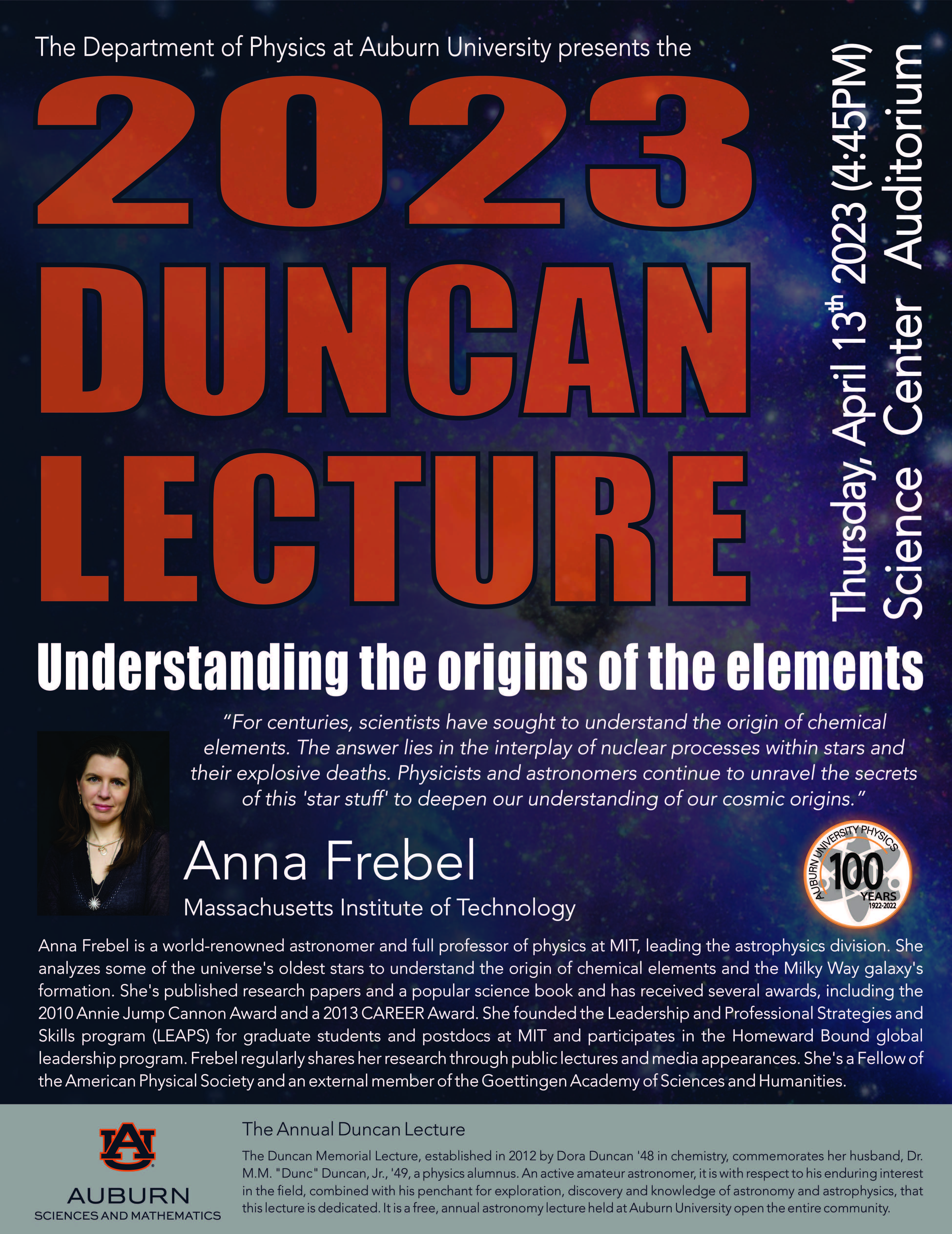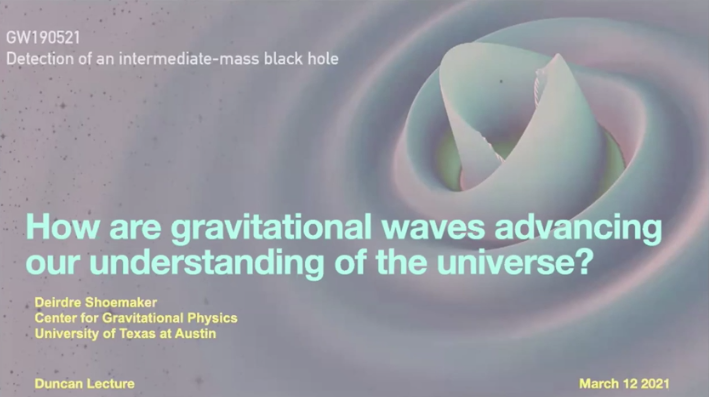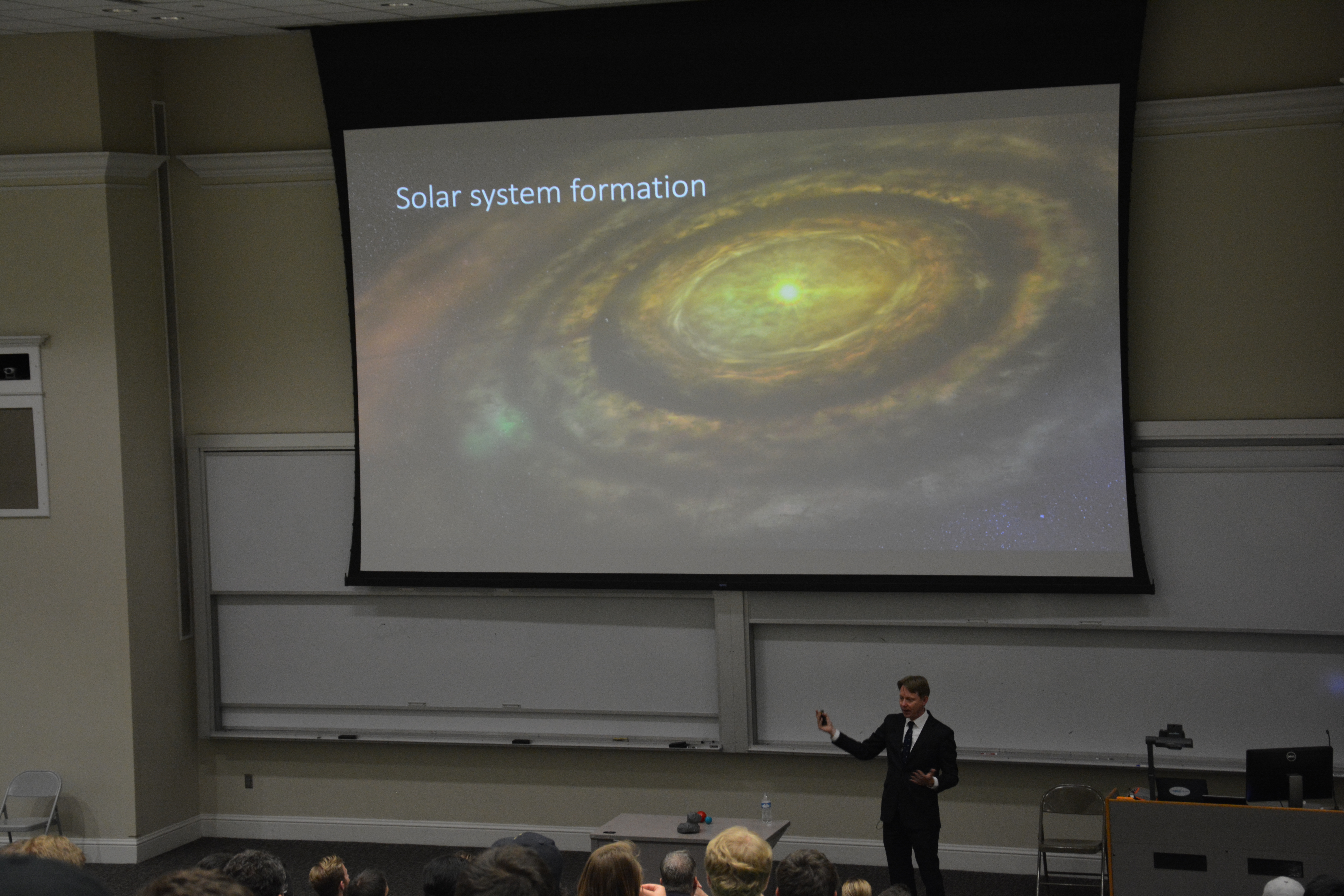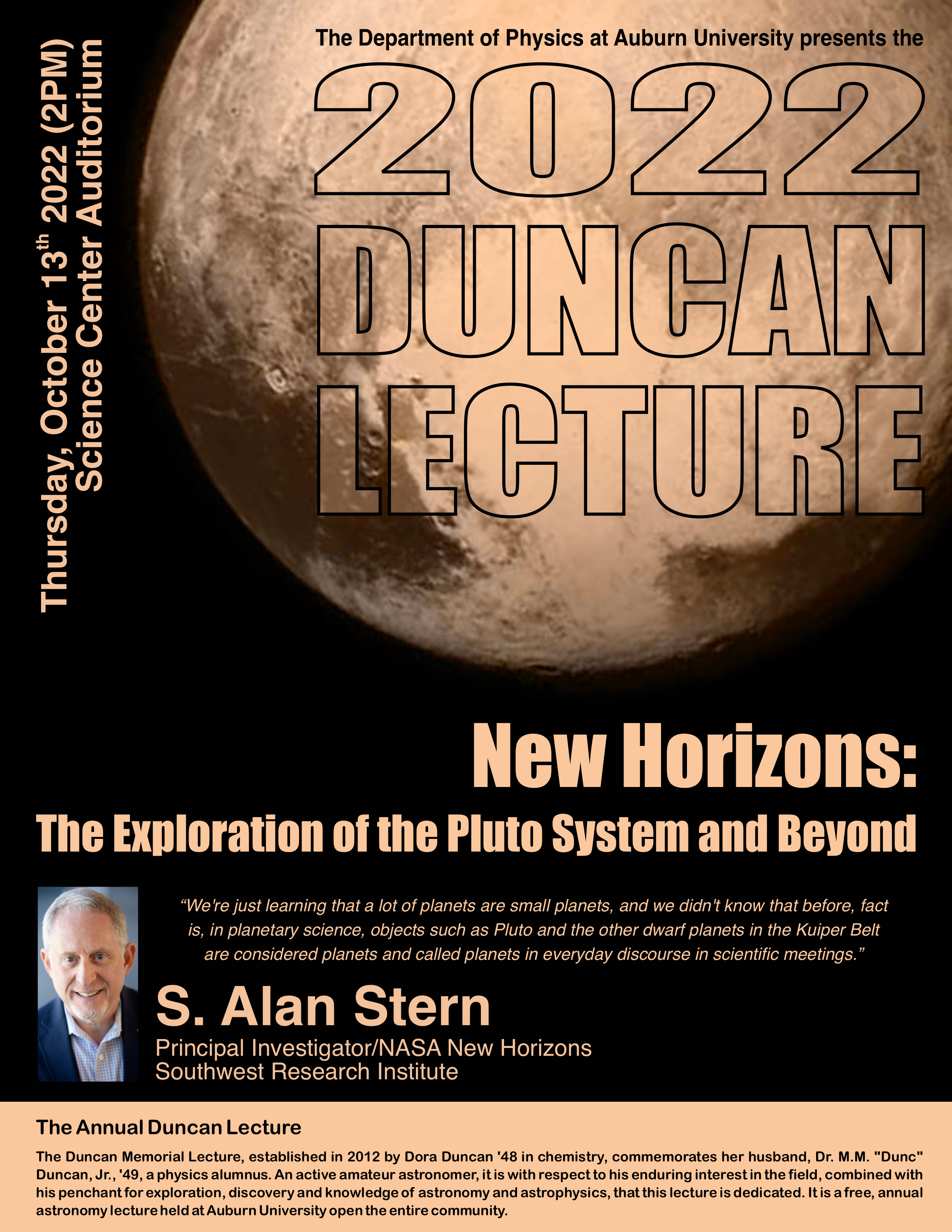Duncan Lecture
The Annual Duncan Lecture in the Department of Physics
2023 - 2013 Duncan Lectures
2023 Duncan Lecture

The 2023 Duncan Memorial Lecture offered an exciting evening celebrating both the arts and sciences in one event. Anna Frebel, professor of physics and head of astrophysics at the MIT Kavil Institute for Astrophysics and Space Research, gave a theatrical performance as nuclear physicist Lise Meitner and then return to herself and spoke on the topic of Understanding the origins of the elements on Thursday, April 13.
Meitner is most famously known for discovering “nuclear fission” or the process of splitting uranium atoms to produce energy. The basis for nuclear reactors, changed the world and impacted numerous areas such as medicine, politics, environmental emissions and the course of history as we know it.
Her story is a reminder that the scientific community must continue to work towards greater diversity, equity, and inclusion to ensure that all scientists are given the recognition they deserve.
Read more about the 2023 Duncan Lecture.
2022 Duncan Lecture
Alan Stern shares spectacular experiences of the first flyby of Pluto at the Annual Duncan Lecture
More than 160 people attended this year’s Duncan Lecture on Oct. 4 to hear from Alan Stern, who has participated in 29 NASA and European Space Agency missions. He is the primary investigator of the New Horizons mission which launched in 2006 and completed the first flyby of Pluto in 2015.
The New Horizons mission has provided images of Pluto and its moons that had never been possible to capture before.
“New Horizons is my absolute favorite mission because it goes out to the frontier of the solar system and a new class of planet,” Stern said.
Pluto is a new class of plant, a third class of planetary bodies called a dwarf planet, which is smaller than the eight classical planets.
“Only by going there can we explore,” he said.
Stern welcomed the faculty, staff and students attending this year’s Duncan Lecture. He has always been interested in space since a young child.
“All I wanted to do growing up was be involved with space exploration and space science,” he explained.
Stern’s career has been filled with major space milestones. However, his journey to Pluto impressed students and researchers in the Science Center Auditorium.
The New Horizons mission is approximately the size of a baby grand piano and weighs about 1,000 pounds,” Stern said. “It is powered by a nuclear generator and completed a half billion miles in just 13 months.”
The craft flew a million miles a day for eight years. It flew past Jupiter, Uranus, and Neptune.
Then in 2015, the New Horizons mission was able to obtain images and data that no one has ever seen or recorded before.
Scientists simply could not get an up-close image with intricate detail even with the Hubble Space Telescope.
“We need quality, high-resolution images to understand the origin and evolution of planets,” said Stern.
The New Horizons mission included flash memory drives to record the data, which took 16 months to send the data back.
“Our goal was to arrive within plus or minus 450 seconds of the original plan when the spacecraft left planet Earth,” said Stern. “We were 86 seconds early and the results were spectacular.”
He and a team of dedicated scientists worked on the entire project from start to finish.
“Working as a team, we flew a spacecraft that we built and explored the farthest worlds in space history,” Stern said.
After the images of Pluto were released, more than 500 newspapers featured this story on their cover above the fold. They story was on every paper on all seven continents—Pluto went around the entire world. It appeared on magazine covers and even a Google Doodle.
New Horizons wasn’t done.
After recoding the data and images of Pluto, New Horizons was still out there flying being powered by that self-contained nuclear generator.
In 2019, New Horizons completed a flyby of Arrokoth, a planetesimal or body that was formed in the Kuiper Belt, which is beyond Neptune’s orbit. It is much smaller than Pluto and has a strange shape, consisting of two flattened lobes.
“New Horizons settled that Arrokoth was built by low-speed collisions,” explained Stern.
And this mission is still out there. It is still flying and has the potential to record more data until its generator loses power.
Stern was not done either.
After his talk, he answered an array of questions in the auditorium and then had a line of undergraduate and graduate students waiting to ask him questions.
New Horizons captured unprecedented images during its mission and Stern inspired Auburn University students to continue the excitement of space exploration and to make their own impact through space.
2021 Duncan Lecture
Annual Duncan Lecture discussed black holes and gravitational waves

“I study objects where all matter has been forgotten,” explained Deirdre Shoemaker, a theoretical physicist who researches the effects black holes have on our universe.

On Friday, March 12, Shoemaker was the featured speaker for the 2021 Annual Duncan Lecture. Her anticipated speech, How are gravitational waves advancing our understanding of the universe, was attended by faculty, staff, and students.
“Large stars can become black holes or extremely dense and complicated neutron stars,” she shared. “I study black holes and their oscillations in space. Think of them as ripples in the fabric of the universe.”
As a professor of physics and director of the Center for Gravitational Physics at the University of Texas at Austin, Shoemaker discussed how gravitational waves were discovered in 2015 with the Laser Interferometer Gravitational-Wave Observatory (LIGO) Scientific Collaboration, 4 kilometer large tunnels that use laserlight to pick up the tiny ripples in space.
“As a graduate student in the late 1990s, I saw an incredible opportunity to study objects in the universe,” she said. “The two LIGO observatories in Hanford Washington and the other in Livingston, Louisiana, were being constructed during that time from 1994 – 2000.”
Shoemaker uses the world’s most powerful computers to understand how black holes end up on collision courses and how this affects the universe around them.
“My team of graduate students and postdocs help me create 3D images of gravitational waves resulting from the collision of two black holes and run calculations to solve for the dynamics of and gravitational radiation emitted by the collision with the help of a supercomputer,” she added
She concluded her presentation with a snapshot of the future.
“Estimated in 2035, in a partnership lead by the European Space Agency and NASA, the LISA Consortium will include 3 satellites orbiting the sun about 2.5 million kilometers apart,” Shoemaker said. “In the next few decades, we will be able to learn even more about our incredible universe.”
Once her presentation was finished, Shoemaker answered questions for more than 30 minutes. An array of undergraduate students, graduate students, alumni, and faculty asked in-depth questions about her research and insight of the world of physics.
Watch the recorded presentation.
2019 Duncan Lecture
Auburn University Associate Professor Dennis Bodewits and Artist Ekaterina Smirnova spoke at the 2019 Duncan Lecture - Water in our solar system.

"Comets are the most primitive materials we can study," explained Dr. Bodewits. His lecture gave audience members insight into the formation of water in our solary system, the late heavy bombardment that took place 3.9 million years ago, how comets evolve, and how to use the molecular fingerprint of heavy water.

View the artwork online of artist Ekaterina Smirnova.

2013 - 2017 Duncan Lectures
- 2017 Annual Duncan Lecture: Dr. David Michael McCollough, Archive Operations, Astrophysicist, Archival Astrophysicist, Center for Astrophysics, Harvard and Smithsonian - Binaries, Cygus X-3 and its little friend.
- 2016 Annual Duncan Lecture: Dr. John C. Mather, Senior Scientist, Cosmology, NASA's Goddard Space Flight Center - The history of the universe from the beginning to the end: Where did we come from, where can we go?
- 2015 Annual Duncan Lecture: Dr. Sara Seager, Professor of Planetary Science and Physics, MIT - The search for Earth 2.0.
- 2014 Annual Duncan Lecture: Dr. Bradley M. Peterson, Professor Emeritus of Astronomy, The Ohio State University - Solving the quasar, A fiftty year quest.
- 2013 Annual Duncan Lecture: Dr. Dan Hooper, Professor, Department of Astronomy and Astrophysics, University of Chicago - In search of our universe's missing mass and energy.

